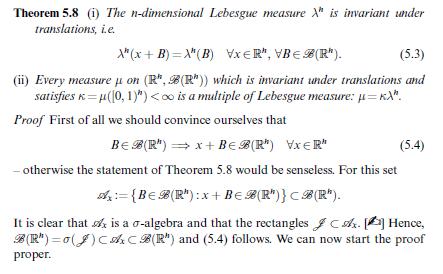Use Jacobi's transformation formula to recover Theorem 5.8(i), Problem 5.9 and Theorem 7.10. In particular, for all
Question:
Use Jacobi's transformation formula to recover Theorem 5.8(i), Problem 5.9 and Theorem 7.10. In particular, for all integrable functions \(u: \mathbb{R}^{n} ightarrow[0, \infty)\)
\[
\begin{aligned}
\int u(x+y) \lambda^{n}(d x) & =\int u(x) \lambda^{n}(d x) & & \forall y \in \mathbb{R}^{n}, \\
\int u(t x) \lambda^{n}(d x) & =\frac{1}{t^{n}} \int u(x) \lambda^{n}(d x) & & \forall t>0, \\
\int u(A x) \lambda^{n}(d x) & =\frac{1}{|\operatorname{det} A|} \int u(x) \lambda^{n}(d x) & & \forall A \in \mathbb{R}^{n \times n}, \operatorname{det} A eq 0 .
\end{aligned}
\]
The left-hand side of any of the above equalities exists and is finite if, and only if, the right-hand side exists and is finite.
Why can't we use Theorem 16.4 to prove these formulae?
Data from theorem 5.8

Data from problem 5.9
Dilations. Mimic the proof of Theorem 5.8(i) and show that \(t \cdot B:=\{t b: b \in B\}\) is a Borel set for all \(B \in \mathscr{B}\left(\mathbb{R}^{n}ight)\) and \(t>0\). Moreover,
\[
\lambda^{n}(t \cdot B)=t^{n} \lambda^{n}(B) \quad \forall B \in \mathscr{B}\left(\mathbb{R}^{n}ight), \forall t>0
\]
Data from theorem 7.10
Use image measures to give a new proof of Problem 5.9 , i.e. show that
\[
\lambda^{n}(t \cdot B)=t^{n} \lambda^{n}(B) \quad \forall B \in \mathscr{B}\left(\mathbb{R}^{n}ight), \quad \forall t>0
\]
Step by Step Answer:






